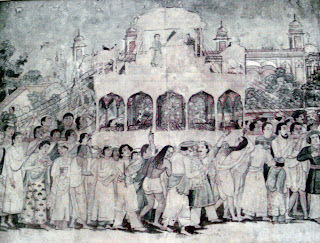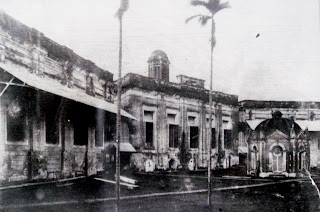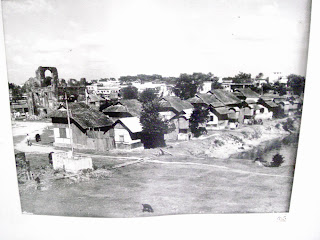
Ruined 'Boro Kutra' ( large caravanserai) built in1664 - drawn by de fabeck-fredrick william alexander in 1863.

Nimtoli Deuri- ruined gateway at Dhaka sketched by de fabeck-fredrick william alexander in1863.

Ruined mosque at Dhaka (Khan Md Mridha Masjid in Lalbagh) - drawn by de fabeck fredrick william alexander in 1863






Husainy Dalan & Muharram Procession: Above is the sketch of Main Imambara of Shia Muslim community erected by Syed Mir Murad during the Governorship of Shah Shuja. The original building may have been a small structure, expanded to its present form in later times. From the first to the tenth day of Muharram, the Husainy Dalan becomes the chief attraction of the city. Mourners, including Sunni Muslims, assemble there, listen to sermons and join in passion plays crying 'Ya Husain, Ya Husain'. On the ashura (tenth day), a great procession parades through the main streets of the city to a place in the western part of the city symbolically called ‘Karbala’. (pic: City Corp museum)

Artist's impression of gathering near Eid-gah, Dhanmondi

Demonstration by 'Gora Paltan' (British troops) at Dhaka in early 19th century

'Ruins of Tongi Bridge' by Charles D'Oyly in 1825

Ruined remains of bridge near Tanti-bazar by D'Oyly in 1814

'Ruined mosque in the suburb of Dhaka' by Charles D'Oyly in 1825

'Ruined mosque on Mogh-bazar Road' by D'Oyly in 1827

'Ruined Small Kutra with enclosed tomb' sketched by Charles D'oyly in 1817.

Ruined 'Part of interior of Dhaka' by D'Oyly in 1814

'Ruined Great Kutra' sketched by D'oyly in 1823

'Ruined north gateway of the Great Kutra' by D'Oyly in 1816

south west view of ruined 'Bastion of Lalbagh Fort' by D'Oyly in 1816


' (Dolai Canal)- drawn by D'Oyly in 1826

Ruined 'Mosque on Buriganga branch' by D'oyly in 1814 (Saat Masjid, Mirpur)

'Ruined Syaff Khan Mosque' by Charles D'oyly in 1914

Armenian Church, built in 1781.

Dhakeswari Mandir - this original features changed due to repeated renovation

Mansion of JP Wise, an influential Zaminder and Indigo-planter, facing the Buriganga river. Presently it is the center of Bulbul Lalit Kala Kendra. Wiseghat of Dhaka has been named after him. There were two other British dignitaries known by the name ‘Wise’ - Dr. T. Wise, the Principal of Dhaka College and Dr. James Wise, Civil Surgeon of Dhaka.

Mitford Hospital: First native hospital of Dhaka built in 1803 from public fund with capacity for 40 patients. Robert Mitford, first British Collector of Dhaka, a bachelor himself, made a will to donate his property for development of this hospital. With further money added from Govt. the hospital was built in 1858 at the present site to accomodate about 100 beds. Construction of hospital was done by M/S Barn & Co.

Chawkbazar: Picture of 1908. An area about 200 yds square was the main business center of Dhaka, established by the Mughals, adjacent to the main fort (present site of Dhaka central jail). Murshid Quli Khan named it Badshahi Bazar.

Citizens waiting at Islampur road to welcome Sir Fuller, Lt. Governor of the province of East Bengal and Assam. (Pic: Fritz Kapp, 1905)

View of Lalbagh Qilla (Fort) early 20th century. Prince Azam, son of Emperor Aurangzeb, Governor of Bengal, originally started its construction in 1678 and named it Qilla Aurangabad. It remained incomplete. The barracks in the foreground built during British rule are quarters for Lalbagh police line.








Eight sketches of Dhaka river front of late 19th century


Old huge tool with sharp edge made of special steel are used by the ‘Shankharis’ (Artisan working with conch shell) of 'Shankhari Bazar', for cutting Conch Shell (above pic) to make bangles etc.




























